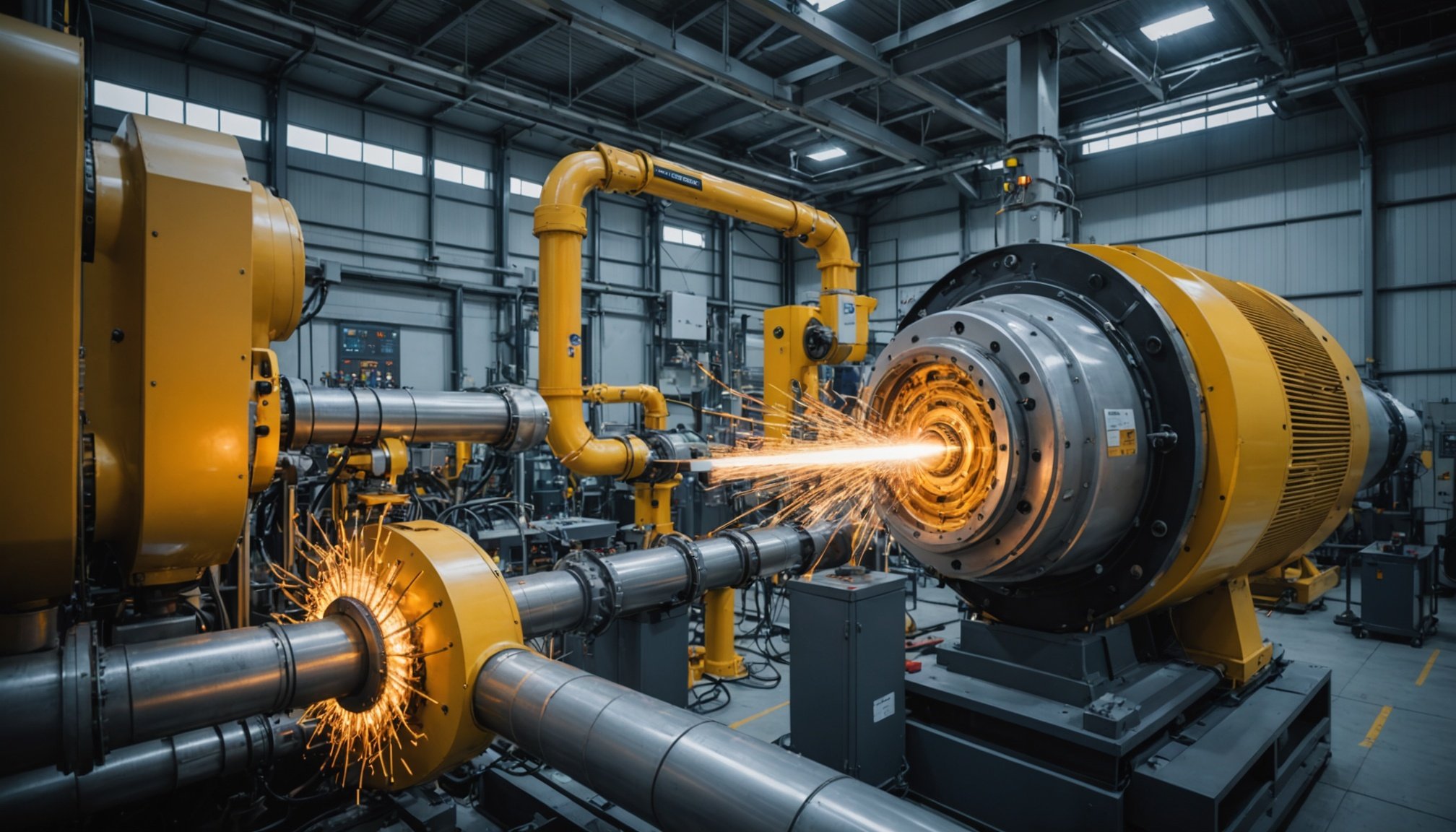Unveiling Advanced AI Breakthroughs in Predictive Maintenance for Sustainable Energy Solutions
The Evolving Landscape of Energy Systems
The energy sector is undergoing a significant transformation, driven by the increasing demand for sustainable and efficient energy solutions. With the forecasted 20% growth in electricity demand by 2030 in the US, as noted by a Wells Fargo analysis, the pressure on existing infrastructure is mounting[1].
To address these challenges, electric utilities are embracing innovative technologies, particularly artificial intelligence (AI) and data analytics. These technologies are not only enhancing maintenance, operations, and investment decisions but also improving the efficiency and resilience of energy systems.
Also to see : Revolutionizing integrity: the role of ai in detecting and preventing plagiarism in online content
The Role of AI in Predictive Maintenance
Predictive maintenance is a cornerstone of modern energy management, and AI is at the forefront of this revolution. Here’s how AI is transforming predictive maintenance:
Analyzing Large Data Sets
AI algorithms can analyze vast amounts of data from various sources such as oil temperature, oil pressure, load, usage stats, weather data, IR scans, and historical maintenance records. This analysis helps predict potential equipment failures before they occur, minimizing downtime and reducing costs[1][3].
Topic to read : Transforming enterprise security: the impact of next-generation firewalls on modern defense strategies
Real-Time Monitoring
AI-powered systems can monitor real-time data from sensors, smart meters, and other devices to detect anomalies and predict future energy consumption patterns. For instance, substation asset health AI tools analyze sensor data from transformers to spot inefficiencies and predict maintenance needs, ensuring that utilities can proactively manage their assets[1].
Machine Learning and Deep Learning
Machine learning (ML) and deep learning algorithms are crucial in predictive maintenance. These algorithms can learn from historical data and anticipate future trends, enabling utilities to forecast when their equipment might fail or need maintenance. Companies like Siemens use AI to predict and prevent wind turbine failures, leading to increased energy output, lower maintenance expenses, and longer asset life[2].
Key Applications of AI in Energy Systems
AI is not just limited to predictive maintenance; it has a broad range of applications in the energy sector.
Energy Grids and Smart Grids
AI algorithms can manage smart grids by analyzing data from smart meters, line sensors, switches, and connected devices. This helps in understanding real-time electricity demand and predicting consumption patterns. For example, Enel, an Italian energy company, uses AI to develop smart grids that increase the efficiency of power generation and reduce carbon emissions[2].
Renewable Energy Integration
AI plays a vital role in integrating renewable energy sources into national grids. By predicting fluctuations in renewable energy generation from sources like solar and wind, AI helps in better grid management. For instance, AI can optimize renewable energy production by adjusting assets based on weather forecasts, ensuring a more reliable energy supply despite the variability of renewables[1][2].
Energy Storage
AI is also crucial in managing energy storage systems. It considers factors such as supply and demand, cost, and grid conditions to determine the optimal time to release and store energy. Companies like Envision Energy use AI and IoT to integrate energy storage systems into smart grid systems, ensuring efficient energy distribution[2].
Demand Response Management
AI helps in demand response management by analyzing consumer usage patterns and incentivizing them to adjust energy consumption during peak demand periods. This reduces the strain on the grid and improves energy efficiency. The EcoStruxure Grid platform from Schneider Electric is a prime example, using AI analytics to optimize demand response across smart grids[2].
Practical Insights and Actionable Advice
Here are some practical insights and actionable advice for implementing AI in predictive maintenance and energy management:
Data Aggregation and Analysis
- Aggregate Data: Collect data from various sources including sensors, smart meters, and historical records.
- Analyze Data: Use advanced analytics platforms to analyze this data and identify patterns and anomalies.
- Implement AI Models: Develop and implement AI models such as machine learning and deep learning algorithms to predict maintenance needs and optimize energy operations[5].
Real-Time Monitoring
- Install Real-Time Monitoring Systems: Use real-time monitoring systems to detect anomalies and predict future energy consumption patterns.
- Act on Insights: Act promptly on the insights provided by these systems to prevent failures and optimize energy distribution[1][3].
Collaboration and Training
- Collaborate with Experts: Collaborate with AI experts and maintenance professionals to develop and implement effective predictive maintenance strategies.
- Train Workforce: Train the workforce on using AI tools and interpreting the data to ensure seamless integration of AI into existing operations[5].
Examples and Case Studies
Several companies and utilities have already seen significant benefits from implementing AI in their operations.
Enel’s Smart Grids
Enel, an Italian energy company, has developed smart grids using AI to increase the efficiency of power generation and reduce carbon emissions. Their AI-powered smart grids can detect faults or disruptions and identify the exact location to minimize downtime[2].
Siemens’ Predictive Maintenance
Siemens uses AI to predict and prevent wind turbine failures. This approach has led to increased energy output, lower maintenance expenses, and longer asset life. By analyzing large data sets from historical maintenance records and usage data, Siemens can forecast when their turbines need to be serviced, reducing downtime and costs[2].
Arcadis’ Predictive AI in Water Utilities
While not directly related to energy, Arcadis’ use of predictive AI in water utilities provides a compelling example of AI’s potential. Arcadis has implemented AI-powered predictive modeling systems to predict pipe failures and optimize water treatment processes. This approach has helped in reducing water loss and securing the financial and environmental future of water utilities[4].
Table: Comparing AI Applications in Energy and Water Utilities
| Application | Energy Utilities | Water Utilities |
|---|---|---|
| Predictive Maintenance | Predict equipment failures in power plants and transmission lines[1][3] | Predict pipe failures and optimize water treatment processes[4] |
| Real-Time Monitoring | Monitor real-time data from sensors and smart meters to detect anomalies[1][3] | Monitor real-time data to predict water consumption patterns and detect leaks[4] |
| Grid Optimization | Optimize power distribution and manage load balancing[1][3] | Optimize water distribution and manage water age[4] |
| Renewable Energy Integration | Predict fluctuations in renewable energy generation and optimize energy production[1][2] | – |
| Energy Storage | Manage energy storage systems to optimize energy release and storage[2] | – |
| Demand Response Management | Analyze consumer usage patterns to optimize energy consumption[2] | – |
| Greenhouse Gas Emissions | Predict and manage carbon emissions to achieve sustainability goals[2] | Predict and manage nitrous oxide (N₂O) emissions to achieve sustainability goals[4] |
The Future of Sustainable Energy Solutions
As we look to the future, it is clear that AI will play a pivotal role in shaping sustainable energy solutions. Here are some key trends and insights:
Increased Adoption of AI
The global market for AI in the energy sector is expected to reach $7.78 billion by the end of 2024, indicating a significant increase in the adoption of AI technologies[2].
Integration of Renewable Energy
AI will continue to be crucial in integrating renewable energy sources into national grids, ensuring a more reliable and efficient energy supply.
Advanced Analytics and Machine Learning
The use of advanced analytics and machine learning algorithms will become more prevalent, enabling utilities to make data-driven decisions and optimize their operations in real-time.
Energy Storage and Management
AI will play a critical role in managing energy storage systems, ensuring that energy is stored and released efficiently to meet demand.
The integration of AI in predictive maintenance and energy management is a game-changer for the energy sector. By leveraging AI, utilities can enhance efficiency, reduce costs, and achieve greater sustainability. As the energy landscape continues to evolve, it is imperative for utilities and energy companies to embrace these advanced technologies to ensure a sustainable and efficient energy future.
Quotes and Insights from Experts
- “AI is pivotal in integrating renewable energy sources into national grids, providing a forward-thinking approach to sustainable energy policy.” – Managing Director, Utilities – Americas, Sand Technologies[1].
- “AI can improve energy efficiency, lower costs, and facilitate the transition to renewable energy sources by anticipating and controlling fluctuations in demand.” – Appinventiv[2].
- “Predictive AI enables utilities to quickly identify potential weak points in their networks, prioritize maintenance efforts, and prevent failures before they occur.” – Celine Hyer, Arcadis[4].
These insights underscore the transformative potential of AI in the energy sector, highlighting its role in driving innovation, efficiency, and sustainability. As we move forward, the integration of AI will be essential for creating a more resilient, efficient, and sustainable energy system.











